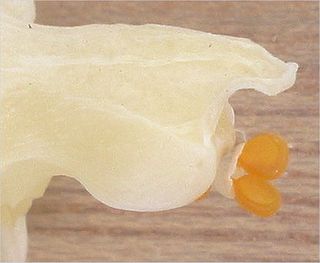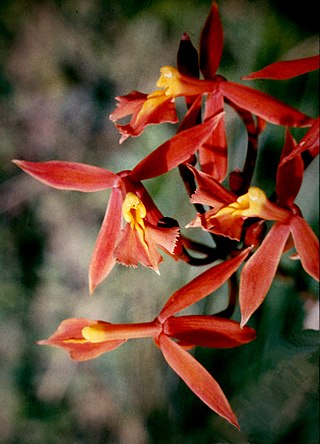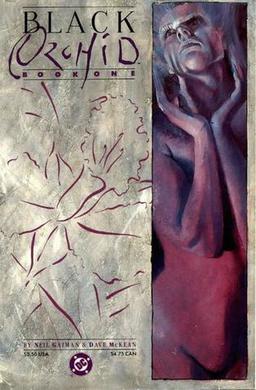
Orchids are plants that belong to the family Orchidaceae, a diverse and widespread group of flowering plants with blooms that are often colourful and fragrant.

Ophrys apifera, known in Europe as the bee orchid, is a perennial herbaceous plant of the family Orchidaceae. It serves as an example of sexually deceptive pollination and floral mimicry, as well as of a highly selective and highly evolved plant–pollinator relationship.

Anacamptis pyramidalis, the pyramidal orchid, is a perennial herbaceous plant belonging to the genus Anacamptis of the family Orchidaceae. The scientific name Anacamptis derives from Greek ανακάμτειν 'anakamptein' meaning 'bend forward', while the Latin name pyramidalis refers to the pyramidal form of the inflorescence.

Bulbophyllum is a genus of mostly epiphytic and lithophytic orchids in the family Orchidaceae. It is the largest genus in the orchid family and one of the largest genera of flowering plants with more than 2,000 species, exceeded in number only by Astragalus. These orchids are found in diverse habitats throughout most of the warmer parts of the world including Africa, southern Asia, Latin America, the West Indies, and various islands in the Indian and Pacific Oceans. Orchids in this genus have thread-like or fibrous roots that creep over the surface of trees or rocks or hang from branches. The stem is divided into a rhizome and a pseudobulb, a feature that distinguished this genus from Dendrobium. There is usually only a single leaf at the top of the pseudobulb and from one to many flowers are arranged along an unbranched flowering stem that arises from the base of the pseudobulb. Several attempts have been made to separate Bulbophyllum into smaller genera, but most have not been accepted by the World Checklist of Selected Plant Families.

The pseudobulb is a storage organ found in many epiphytic and terrestrial sympodial orchids. It is derived from a thickening of the part of a stem between leaf nodes and may be composed of just one internode or several, termed heteroblastic and homoblastic respectively. All leaves and inflorescences usually arise from this structure. Pseudobulbs formed from a single internode produce the leaves and inflorescence from the top, while those that are formed from several internodes can possess leaves along its length. The modified sheath leaves that appear at the base of a pseudobulb and often enfold all or part of it are usually dry and papery, though in some orchids the sheaths bear leaf blades and the leaves at the pseudobulb's apex are reduced to scales.

Black Orchid is the name of four superheroines published by DC Comics. The original version of the character first appeared in Adventure Comics #428.

Dendrobium is a genus of mostly epiphytic and lithophytic orchids in the family Orchidaceae. It is a very large genus, containing more than 1,800 species that are found in diverse habitats throughout much of south, east and southeast Asia, including China, Japan, India, the Philippines, Indonesia, Australia, New Guinea, Vietnam and many of the islands of the Pacific. Orchids in this genus have roots that creep over the surface of trees or rocks, rarely having their roots in soil. Up to six leaves develop in a tuft at the tip of a shoot and from one to a large number of flowers are arranged along an unbranched flowering stem. Several attempts have been made to separate Dendrobium into smaller genera, but most have not been accepted by the World Checklist of Selected Plant Families.

The Singapore Botanic Gardens is a 164-year-old tropical garden located at the fringe of the Orchard Road shopping district in Singapore. It is one of three gardens, and the only tropical garden, to be honoured as a UNESCO World Heritage Site. The Botanic Gardens has been ranked Asia's top park attraction since 2013, by TripAdvisor Travellers' Choice Awards. It was declared the inaugural Garden of the Year by the International Garden Tourism Awards in 2012.

A pollinium is a coherent mass of pollen grains in a plant that are the product of only one anther, but are transferred, during pollination, as a single unit. This is regularly seen in plants such as orchids and many species of milkweeds (Asclepiadoideae). Usage of the term differs: in some orchids two masses of pollen are well attached to one another, but in other orchids there are two halves each of which is sometimes referred to as a pollinium.

In botany, the labellum is the part of the flower of an orchid or Canna, or other less-known genera, that serves to attract insects, which pollinate the flower, and acts as a landing platform for them.

Anacondas: The Hunt for the Blood Orchid is a 2004 American adventure horror film directed by Dwight Little. It is a stand-alone sequel to the film Anaconda (1997) and the second installment of the Anaconda film series. The film follows a team of researchers set for an expedition into the Southeast Asian tropical island of Borneo, to search for a sacred flower for which they believe will bring humans to a longer and healthier life, but soon become stalked and hunted by the deadly giant anacondas inhabiting the island.

Orchid Island, also known by other names, is a 45 km2 (17 sq mi) volcanic island off the southeastern coast of Taiwan, which Orchid Island is part of. It is separated from the Batanes of the Philippines by the Bashi Channel of the Luzon Strait. It is governed as Lanyu Township of Taitung County, Taiwan Province, Republic of China which also includes the nearby Lesser Orchid Island.

Epidendroideae is a subfamily of plants in the orchid family, Orchidaceae. Epidendroideae is larger than all the other orchid subfamilies together, comprising more than 15,000 species in 576 genera. Most epidendroid orchids are tropical epiphytes, typically with pseudobulbs. There are, however, some terrestrials such as Epipactis and even a few myco-heterotrophs, which are parasitic upon mycorrhizal fungi.

The Tao people are an Austronesian ethnic group native to the tiny outlying Orchid Island of Taiwan. They have a maritime culture, with great ritual and spiritual significance placed on boat-building and fishing. Their ways of life have been threatened by the continued emigration to the mainland of Taiwan in search of jobs and education. As a result, the continuation of past traditions has been hindered. Despite being linked to both other Taiwanese indigenous peoples and Batanic indigenous Filipino populations, the Tao people remain unique in their customs and cultural practices.

Caladenia, commonly known as spider orchids, is a genus of 350 species of plants in the orchid family, Orchidaceae. Spider orchids are terrestrial herbs with a single hairy leaf and a hairy stem. The labellum is fringed or toothed in most species and there are small projections called calli on the labellum. The flowers have adaptations to attract particular species of insects for pollination. The genus is divided into three groups on the basis of flower shape, broadly, spider orchids, zebra orchids and cowslip orchids, although other common names are often used. Although they occur in other countries, most are Australian and 136 species occur in Western Australia, making it the most species-rich orchid genus in that state.

Papilionanthe Miss Joaquim, also known as the Singapore orchid, the Princess Aloha orchid and formerly as Vanda Miss Joaquim, is a hybrid orchid that is the national flower of Singapore. For its resilience and year-round blooming quality, it was chosen on 15 April 1981 to represent Singapore's uniqueness and hybrid culture.
Royal Orchid Hotels a hotel chain operating hotels in India and Kenya.
Kõrgessaare Nature Reserve is a nature reserve situated on Hiiumaa island in western Estonia, in Hiiu County.

Salep, also spelled sahlep or sahlab, is a flour made from the tubers of the orchid genus Orchis. These tubers contain a nutritious, starchy polysaccharide called glucomannan. Salep flour is consumed in beverages and desserts, especially in the cuisines of the former Ottoman Empire, notably in the Levant where it is a traditional winter beverage. An increase in consumption is causing local extinctions of orchids in parts of Turkey and Iran.

Black Orchid is an American comic book written by Neil Gaiman with art by Dave McKean. It was published by DC Comics as a three-issue limited series from December 1988 to February 1989, and was later reprinted in trade paperback form. Black Orchid follows two girls, Flora and Suzy, who awaken in a greenhouse. Their journey to find out who they are leads them into contact with DC Universe figures like Batman and Swamp Thing, but also into conflict with criminal mastermind Lex Luthor, who seeks them for his own interests.

















